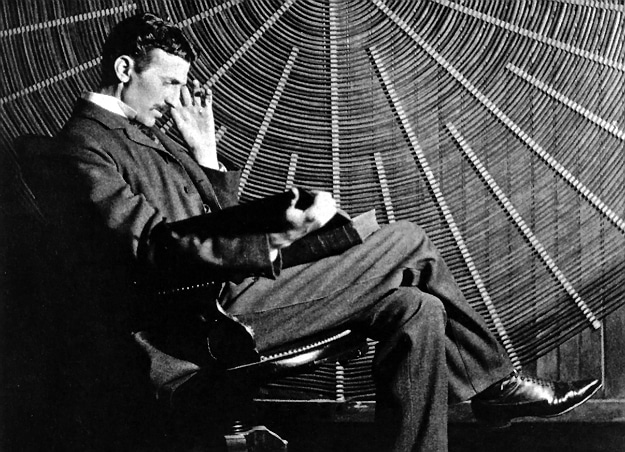Nikola Tesla is probably best known for his contributions to the design of the modern alternating current (AC) electricity supply. For those of you who don’t know who Tesla is, he’s the guy played by David Bowie in the film ‘The Prestige’ – which if you haven’t seen, you really must!
Tesla could also be described as your stereotypical “mad scientist”, tinkering with all sorts of contraptions in his time, including a “Death Ray” he worked on in the 1930’s.
Tesla drew inspiration for his Death Ray from a pop gun he had as a child. The pop gun is essentially an early form of what we now know as air pistols, where you pumped air into the barrel and it would fire off a cork from the end of the gun – but we’ll delve deeper into that later.
Where Did It All Start?
It may sound like it started on the Death Star, but Tesla’s work can be traced back a little earlier than that… Right back to 1893, in fact, with his invention of the button lamp, and again in 1896 when he followed in the footsteps of William Roentgen, the discoverer of X-rays.
But instead of taking close-up X-rays like we are used to nowadays, Tesla was “shooting” his rays over some pretty impressive distances. In fact, he was able to photograph skeletons from as far as 40 feet from where he was stood with his X-ray gun.
[pullquote]Staying on the shooting scene, Tesla was involved in experiments where he was firing cathode rays at targets.[/pullquote] This, alongside similar work from a former colleague of Tesla’s called J.J. Thompson, led to the discovery of the electron by Thompson.
Skip forward to 1918 and Tesla has managed to build himself a laser-like device which he shot at the moon in a Lunar Laser Ranging experiment. Being the mad scientist that he was, Tesla managed to create this device from the components used in his button lamp which we mentioned above, which begs the question; how can a lamp also be a laser gun?
The lamp was created in such a way that a piece of matter, such as carbon, was placed in the center. This matter then played the part of the “button”, which would then be bombarded with electrical energy. This energy would bounce onto the inside of the glass casing it was held in and then bounce back onto the button.
This process led to a “pencil-thin” line of light being created from the device, and it is believed that this same process was used by Tesla to send laser pulses to the moon.
Building The Particle Beam Weapon
So, Mr. Tesla has the laser but it would not have the energy required to be destructive, as it would disperse somewhat over long distances. He, therefore, came to the conclusion that he would shoot microscopic pellets, drawing inspiration from his childhood pop gun. This would stop the laser from dispersing as, theoretically, it would be on pellet thick.
After some further studying of the Van de Graaff generator (which used a cardboard belt to generate high voltages) Tesla created a set-up which had an ionized stream of air capable of repelling small tungsten pellets out of an open-ended vacuum tube, which was shaped like a cannon. Lo and behold, he had his very own Death Ray, or as Tesla named it, Teleforce.
Tesla was extremely confident in his invention, having some bold claims about its capabilities. Speaking in 1934, he said the Teleforce could “send concentrated beams of particles through the free air, of such tremendous energy that they will bring down a fleet of 10,000 enemy airplanes at a distance of 200 miles from a defending nation’s border and will cause armies to drop dead in their tracks.”
Now what?
Tesla described his invention as the superweapon that would put an end to all war and set out pitching his design to multiple parties, including the United Kingdom, the U.S. War Department, Yugoslavia and the Soviet Union, during World War II.
Out of all of the parties, the Soviet Union showed the most interest, partially testing it in 1939. For allowing them to do this, Tesla was paid $25,000 – the equivalent to $431,128.57 in 2017. However, not all was as it seemed, with Tesla claiming that attempts were made to steal his design after finding his room was entered and his papers scattered.
Fortunately, the thieves left empty-handed as the blueprint for the weapon was stored in the most secure place possible – Tesla’s mind.
Did The Building Of The Weapon Actually Ever Take Place?
Of course, we mentioned that the Soviet Union partially tested the weapon, but questions still remain about if the full weapon was ever built or if it was just a smaller version. It is believed that the weapon was actually designed to be a giant tower. The shaft of the tower, which could have been as tall as 100 feet, would contain the “belt” of the ionized air stream. This device would be able to take down aircraft from as far away as 300 miles, which would have been a significant advantage during World War II.
Both the United States and the Soviet Union developed a charged-particle beam weapon during the Cold War, which had an uncanny resemblance to Tesla’s designs. But what about a weapon from the man himself?
During a celebration in his honor, when Tesla was an older man of 81-years-old and discussing the Teleforce, he said: “But it is not an experiment… I have built, demonstrated and used it. Only a little time will pass before I can give it to the world.”
So, if Tesla was telling the truth about his invention, what happened to it…?


COMMENTS